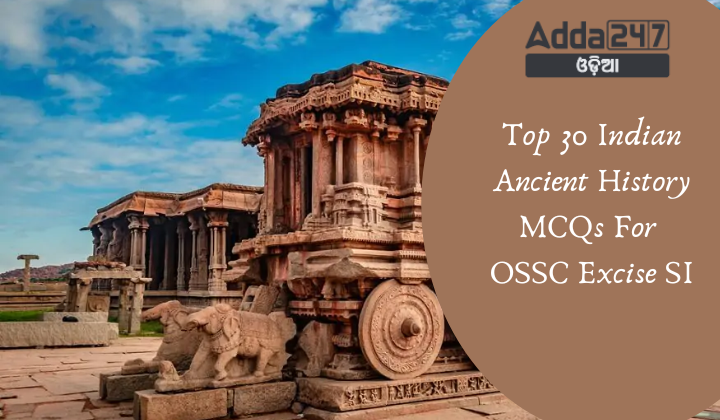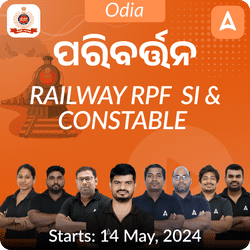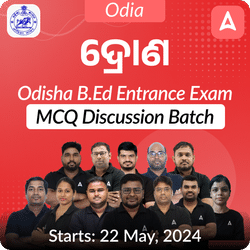Are you preparing for the Odisha Staff Selection Commission (OSSC) Excise Sub-Inspector (SI) exam and looking for a comprehensive study material on Indian Ancient History? Indian Ancient History is a crucial part of the OSSC Excise SI syllabus, covering significant events, dynasties, and cultural aspects of ancient India. To aid your preparation, we’ve compiled a set of the top 30 Multiple Choice Questions (MCQs) on Indian Ancient History that are likely to appear in the exam.
Top 30 Indian Ancient History MCQs For OSSC Excise SI
- Which one of the following pairs is incorrectly matched?
A. Askini – Chenab
B. Sutudri – Sutlej
C. Vipas – Jhelum
D. Parushni – Ravi
Ans: C. Vipas – Jhelum - The origin of Indian music can be traced to which of the following Vedic Samhitas?
A. Rigveda
B. Samaveda
C. Yajurveda
D. Atharvaveda
Ans: B. Samaveda - The first elaborate description of Upanayana Sanskar is found in the
A. Aitareya Brahmana
B. Taittiriya Brahmana
C. Tandyamaha Brahmana
D. Shatapatha Brahmana
Ans: C. Tandyamaha Brahmana - Which of the following pairs is correctly matched?
A. Buddhist monastery
B. Buddhist order or organisation
C. A kind of tomb where the relics of Buddha and other Buddhist monks are kept
D. A Buddhist assembly hall or temple
Ans: C. A kind of tomb where the relics of Buddha and other Buddhist monks are kept - Which one of the following sources states that Srinagar was built by Ashoka?
A. Kalhana’s Rajatarangini
B. Divyavadana
C. Tarantha’s History of Tibet
D. Mahavamsa
Ans: A. Kalhana’s Rajatarangini - Which one of the following pairs does not belong to the same category?
A. Mauryas – Brihadratha
B. Satavahanas – Simuka
C. Sungas – Devabhuti
D. Kanvas – Susaraman
Ans: B. Satavahanas – Simuka - Patanjali, the second great grammarian of Ancient India, was a contemporary of
A. Kanishka
B. Chandragupta-II
C. Gautamiputra Satakarni
D. Pushyamitra Sunga
Ans: D. Pushyamitra Sunga - Who was the founder of the Satavahana dynasty?
A. Sri Satakarni
B. Simuka
C. Pulumayi-I
D. Yajnasri Satakarni
Ans: B. Simuka - Who was the founder of the Kanva dynasty?
A. Suserman
B. Vishnusarma
C. Vassudeva
D. Vasumitra
Ans: C. Vassudeva - Who started the Saka Era and when?
A. Kadphises in 58 BC
B. Rudradaman-I in 78 AD
C. Vikramaditya in 58 BC
D. Kanishka in 78 AD
Ans: D. Kanishka in 78 AD - Which of the following rulers was a contemporary of the famous Buddhist scholar Ashvaghosha?
A. Ashoka
B. Bindusara
C. Harsha
D. Kanishka
Ans: D. Kanishka - Gupta period is often termed the ‘Golden Age’ of ancient India. Which statement best explains this?
Assertion (A): The Gupta rulers issued gold coins.
Reason (R): Both A and R are true but R is not a correct explanation of A.
Codes:
A. Both A and R are true and R is the correct explanation of A
B. Both A and R are true but R is not a correct explanation of A
C. A is true but R is false
D. A is false but R is true
Ans: B. Both A and R are true but R is not a correct explanation of A - Nalanda’s significance in the post-Gupta period is often attributed to being the center of Buddhist learning. What explains this significance?
Assertion (A): Nalanda was the center of Buddhist learning in the post-Gupta period.
Reason (R): It was patronized by the Pal a rulers.
Codes:
A. Both A and R are true and R is the correct explanation of A
B. Both A and R are true but R is not a correct explanation of A
C. A is true but R is false
D. A is false but R is true
Ans: B. Both A and R are true but R is not a correct explanation of A - Regarding the adoption of Jainism in ancient India:
Assertion (A): In the beginning, only high caste Kshatriya communities adopted Jainism.
Reason (R): Vardhaman Mahavira belonged to a well-known Kshatriya community.
Codes:
A. Both A and R are true and R is the correct explanation of A
B. Both A and R are true but R is not a correct explanation of A
C. A is true but R is false
D. A is false but R is true
Ans: B. Both A and R are true but R is not a correct explanation of A - Chandragupta Maurya’s military campaign against Magadha is a significant event. What accurately describes this campaign?
Assertion (A): Chandragupta Maurya failed in his first campaign against Magadha.
Reason (R): He did not begin with the frontiers, but invaded the heart of Magadha.
Codes:
A. Both A and R are true and R is the correct explanation of A
B. Both A and R are true but R is not a correct explanation of A
C. A is true but R is false
D. A is false but R is true
Ans: A. Both A and R are true and R is the correct explanation of A - Jainism incorporates the worship of images of tirthankaras. What explains this practice?
Assertion (A): The Jainas follow the practice of worshipping images of tirthankaras.
Reason (R): They denied the existence of a Supreme Being.
Codes:
A. Both A and R are true and R is the correct explanation of A
B. Both A and R are true but R is not a correct explanation of A
C. A is true but R is false
D. A is false but R is true
Ans: B. Both A and R are true but R is not a correct explanation of A - The issuance of gold coins by the Kushanas is tied to a particular aspect of their era. What explains this?
Assertion (A): The Kushanas issued a large number of gold coins.
Reason (R): The period was marked by flourishing trade.
Codes:
A. Both A and R are true and R is the correct explanation of A
B. Both A and R are true but R is not a correct explanation of A
C. A is true but R is false
D. A is false but R is true
Ans: A. Both A and R are true and R is the correct explanation of A - The presence of temples or public places of worship in the Indus civilization is a matter of debate. What accurately describes this?
Assertion (A): There is no conclusive proof of the presence of temples or public places of worship in the Indus civilization.
Reason (R): To the Harappans, religion was perhaps more a personal and a private matter than a public affair.
Codes:
A. Both A and R are true and R is the correct explanation of A
B. Both A and R are true but R is not a correct explanation of A
C. A is true but R is false
D. A is false but R is true
Ans: C. A is true but R is false - The Harappan civilization exhibits variations in different aspects. What accurately describes this?
The Harappan civilizations do not have homogeneity or uniformity in:
A. weights and measures
B. cereal crops
C. burial practices
D. both (B) and (C)
Ans: C. burial practices - Preservation efforts for Harappan sites showcase their significance. What accurately identifies one such site and its conservation?
A prominent Harappan site, being surrounded by flood barriers in order to protect it with the aid of UNESCO funds, is:
A. Mohenjodaro
B. Dholavira
C. Lothal
D. Rakhigarhi
Ans: A. Mohenjodaro - What type of cities were Harappa and Mohenjo-Daro?
a) Religious cities
b) Unplanned cities
c) Planned cities
d) Merchant cities
Ans: c) Planned. The remaining Mohenjo-Daro and Harappa show that they were completed and planned as a city with a lot of modern techniques. They had roads that were laid out along a grid pattern intersecting each other at right angles. - The reign of Chandragupta-I started in the year-
a) 367 A.D.
b) 305 A.D.
c) 307 A.D
d) 319 A.D.
Ans: (d) 319 A.D. The reign of Chandragupta-I started in 319 A.D. till 335/336 CE. - Which was the largest empire in India?
a) Mughal empire
b) Maurya empire
c) Maratha empire
d) Kushan empire
Ans: (b) Maurya empire. The largest empire of India was the Maurya empire. It was spread up to 50,00,000 Kilometres up to 250 BC. - Who is the founder of the Gupta dynasty?
a) Samudragupta
b) Chandragupta-I
c) Vishnugupta
d) Sri Gupta
Ans: (d) Sri Gupta. From 240 AD to 280 AD, Sri Gupta founded the Gupta dynasty. He was the Maharaja of the Gupta dynasty. The successors of the Gupta dynasty were, Chandragupta, Samudragupta, and Vishnugupta. - Which is the largest civilization in the world?
a) China Civilization
b) Indus valley civilization
c) Mesopotamian civilization
d) Egypt civilization
Ans: (a) Indus valley civilization. The world’s largest civilization is the Indus valley civilization which was spread over 1260,000 sq. Km. The 8000 old civilization was also known as the Harrapan civilization. - In how many parts the history of India is divided?
a) 3
b) 4
c) 8
d) 2
Ans: (a) 3. The History of India is divided into 3 parts. Ancient India History, Mediaeval Indian history, and modern Indian history. - Which period of history marks the Independence of India
a) Ancient history
b) Mediaeval history
c) Modern Indian history
d) None of these
Ans: (c) Modern Indian history. Modern Indian history marks the Independence of India. 1857, marks the first war of Indian Independence. - Which is the most famous seal found from the Harrapan civilization?
a) Animal seal
b) Pashupati seal
c) Long seal M-1271
d) All of the above
Ans: (b) Pashupati seal. The Archaeologist found the Pashupati seal and thousands of similar seals were found in the Harappan cities. The Pashupati seal was found in Mohenjo-Daro. The seal is a figure seated cross-legged in the center with animals around. - What was the major economic source of the Indus valley civilization?
a) Making weapons
b) Agriculture
c) Trading (buying and selling goods)
d) All of the above
Ans: (b) Agriculture. Indus valley civilization was an agricultural-based civilization. Agriculture was the major income. - What is the source of Hindu Philosophy?
a) Law books
b)Vedas
c)Puranas
d)Upanishads
Ans: (d) Upanishads. The Upanishads are a collection of the written text of religious teachings and philosophy.










